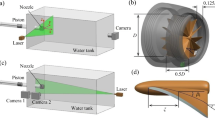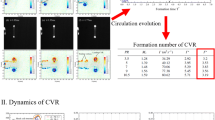Abstract
The dynamics of vortex rings generated within confined domains are relevant to important hydrodynamic processes such as flow past heart valves or severe arterial constrictions. However, despite their importance, these flows have not received much attention to date. This study examines the development and evolution of radially confined vortex rings. Time-resolved digital particle image velocimetry was used to investigate two levels of radial confinement and a range of vortex ring strengths. We found that for severely confined vortex rings, the formation time and peak circulation values were unaffected for L/D 0 < 4 cases and slightly affected for larger L/D 0 cases. After pinch-off, circulation decay was observed with an approximately constant normalized circulation decay rate. We found that with increasing circulation strength, the nondimensional time delay between the pinch-off and the onset of circulation decay reduced due to an increased vortex ring diameter within the confinement domain and a reduction in the necessary time for the surface induced and core vorticity regions to interact. This study uncovers the dynamics of radially confined vortex rings and show that the nondimensional rate of circulation decay is dependent on the vortex ring confinement ratio (ratio of the vortex ring orifice diameter to the diameter of the outer cylinder), and the time delay between the vortex pinch-off and the onset of circulation is dependent on the vortex ring circulation strength.









Similar content being viewed by others
Abbreviations
- a :
-
Vortex core radius
- D :
-
Diameter of the confinement domain
- D 0 :
-
Diameter of the piston cylinder
- D VR :
-
Vortex ring core-to-core diameter
- FN:
-
Formation number
- L :
-
Length of the piston travel
- P :
-
Velocity program factor
- Re :
-
Reynolds number
- Re J :
-
Modified Reynolds number
- T*:
-
Nondimensional formation time
- W*:
-
Normalized vorticity
- Γ:
-
Circulation
- Γ0 :
-
Peak circulation
- ν:
-
Kinematic viscosity
- ω:
-
Vorticity
References
Auerbach D (1988) Some open questions on the flow of circular vortex rings. Fluid Dyn Res 3:209–213
Baccani B, Domenichini F, Pedrizzetti G (2002) Vortex dynamics in a model left ventricle during filling. Eur J Mech B Fluids 21:527–543
Chakraborty P, Balachandar S, Adrian R (2005) On the relationships between local vortex identification schemes. J Fluid Mech 535:189–214
Chang T, Hertzberg J, Kerr R (1997) Three dimensional vortex/wall interaction: entrainment in numerical simulation and experiment. Phys Fluid 9:57
Dabiri J, Gharib M (2004) Delay of vortex ring pinchoff by an imposed bulk counterflow. Phys Fluid 16:L28
Didden N (1977) Ph.D. Dissertation. University of Gottingen
Didden N (1979) On the formation of vortex rings: rolling-up and production of circulation. Z Angew Math Phys 30:101–116
Eckstein A, Vlachos P (2009a) Assessment of advanced windowing techniques for DPIV. Meas Sci Technol 20:075402
Eckstein A, Vlachos P (2009b) Digital particle image velocimetry (DPIV) robust phase correlation. Meas Sci Technol 20:055401
Eckstein AC, Charonko J, Vlachos P (2008) Phase correlation processing for DPIV measurements. Exp Fluids 45:485–500
Escudier MP, Bornstein J, Maxworthy T (1982) The dynamics of confined vortices. Proc R Soc Lond A Math Phys Eng Sci 382:335–360
Etebari A, Vlachos P (2005) Improvements on the accuracy of derivative estimation from DPIV velocity measurements. Exp Fluids 39:1040–1050
Gharakhani A, Ghoniem AF (1998) Simulation of the piston driven flow inside a cylinder with an eccentric port. J Fluids Eng 120:319–326
Gharib M, Rambod E, Shariff K (1998) A universal time scale for vortex ring formation. J Fluid Mech 360:121–140
Glezer A (1988) The formation of vortex rings. Phys Fluid 31:3532
Hertzberg J, Ho C (1995) Three-dimensional vortex dynamics in a rectangular sudden expansion. J Fluid Mech 289:1–27
Hinkley DV (1971) Inference about the change-point from cumulative sum tests. Biometrika 58:509–523
Jeong J, Hussain F (1995) On the identification of a vortex. J Fluid Mech 285:69–94
Kheradvar A, Gharib M (2009) On mitral valve dynamics and its connection to early diastolic flow. Ann Biomed Eng 37:1–13. doi:10.1007/s10439-008-9588-7
Kheradvar A, Milano M, Gharib M (2007) Correlation between vortex ring formation and mitral annulus dynamics during ventricular rapid filling. ASAIO J 53:8–16. doi:10.1097/01.mat.0000249870.44625.22
Krueger P (2008) Circulation and trajectories of vortex rings formed from tube and orifice openings. Phys D Nonlinear Phenom 237:2218–2222
Morton B (1984) The generation and decay of vorticity. Geophys Astrophys Fluid Dyn 28:277–308
Peterson SD, Plesniak MW (2008) The influence of inlet velocity profile and secondary flow on pulsatile flow in a model artery with stenosis. J Fluid Mech 616:263–301. doi:10.1017/S0022112008003625
Pierrakos O, Vlachos PP (2006) The effect of vortex formation on left ventricular filling and mitral valve efficiency. J Biomech Eng-Trans ASME 128:527–539. doi:10.1115/1.2205863
Rosenfeld M, Rambod E, Gharib M (1998) Circulation and formation number of laminar vortex rings. J Fluid Mech 376:297–318
Scarano F (2002) Iterative image deformation methods in PIV. Meas Sci Technol 13:R1–R19
Shariff K, Leonard A (1992) Vortex rings. Annu Rev Fluid Mech 24:U235–U279
Sirovich L (1987) Turbulence and the dynamics of coherent structures. I- Coherent structures. II- Symmetries and transformations. III- Dynamics and scaling. Q Appl Math 45:561–571
Smith T, Moehlis J, Holmes P (2005) Low-dimensional modelling of turbulence using the proper orthogonal decomposition: a tutorial. Nonlinear Dyn 41:275–307
Taylor WA (2000) Change-point analysis: a powerful new tool for detecting changes. http://www.variation.com/cpa/tech/changepoint.html. Accessed 18 July 2008
Westerweel J, Scarano F (2005) Universal outlier detection for PIV data. Exp Fluids 39:1096–1100
Yazdani SK, Moore JE, Berry JL, Vlachos PP (2004) DPIV measurements of flow disturbances in stented artery models: adverse affects of compliance mismatch. J Biomech Eng Trans ASME 126:559–566. doi:10.1115/1.1797904
Zhou J, Adrian R, Balachandar S, Kendall T (1999) Mechanisms for generating coherent packets of hairpin vortices in channel flow. J Fluid Mech 387:353–396
Acknowledgments
The authors would like to thank John J. Charonko and Casandra L. Niebel for their help with this work. This work was partially supported by a National Science Foundation Graduate Research Fellowship as well as National Science Foundation Grant (0547434). Any opinions, findings, conclusions, or recommendations expressed in this publication are those of the authors and do not necessarily reflect the views of the National Science Foundation.
Author information
Authors and Affiliations
Corresponding author
Rights and permissions
About this article
Cite this article
Stewart, K.C., Vlachos, P.P. Vortex rings in radially confined domains. Exp Fluids 53, 1033–1044 (2012). https://doi.org/10.1007/s00348-012-1343-z
Received:
Revised:
Accepted:
Published:
Issue Date:
DOI: https://doi.org/10.1007/s00348-012-1343-z




